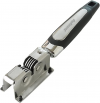I think people are spending far too much time seeking the
hardest edge and missing the
best overall knife.
Numbers are just numbers, they aren't knives. Performance and reliability are what matters. Before folks had readily available hardness testers no one cared if it was Rc62 or Rc64. Both were hard.
Look at the charts and find the sweet spot where hardness and toughness meet. If it is 62 ... fine, if it is 60 ... fine. You or a user will not see any difference in use in the two when cutting kindling or gutting a pike. What you may see is a broken blade if the hardness is considered more important than the toughness.
I remember when most all knives were mid-Rc50's. Everyone thought that was perfectly fine. I agree that Rc60 is better than Rc55 because it will not need sharpening as soon, but the difference between Rc60-62 and Rc 63-64 is not a performance noticeable difference. You can show the difference in repeat cut testing, but when was the last time you went camping and had to cut a rope 1000 times and then shave your arm?
I feel that in carbon steels a balance of toughness and hardness should be weighted on the toughness side and in stainless steels it is corrosion resistance vs hardness.
Personally, I have increased my standard blade hardness from 59-60 to 61-62. However, it is a rare knife I push to 64 unless there is a very special reason like a special alloy (MagnaCut).
I also feel that mastering a couple steels is far better than using many steels with unpredictable results. I use mainly three stainless steels - AEB-L, S35-VN, and Magnacut. For carbon, and mainly W2, 26C3. and a Tungsten alloy like Wolfram Special. Those six steels will perform well, and I know my HT protocol.
Just a fun romp through my past - How many of you remember when the go-to sharpener for a razor-edged knife was a stack of hardened W-2 washers???
$5 cost and they lasted 50 years. They sharpened Rc5-565 blades in seconds with a hollow ground edge.

.




